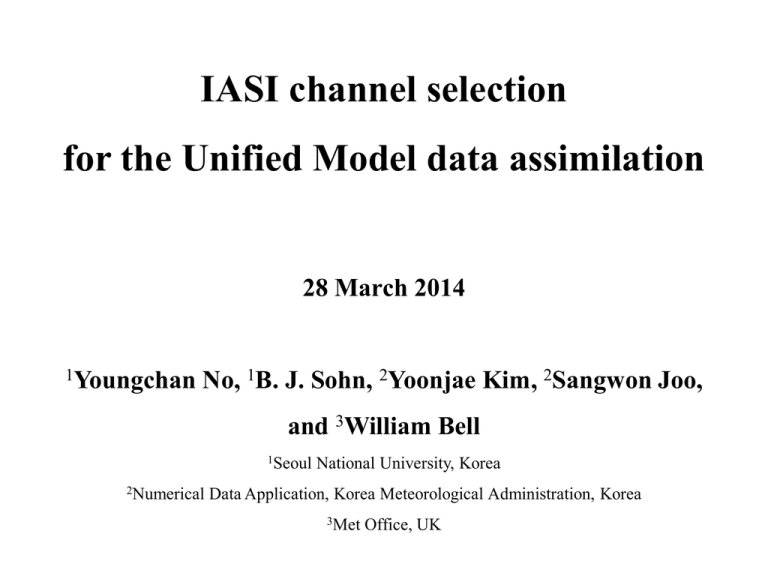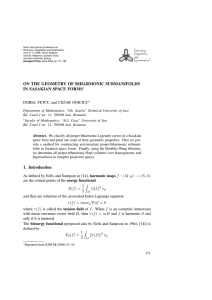IASI channel selection for the Unified Model data assimilation 28 March 2014
advertisement

IASI channel selection for the Unified Model data assimilation 28 March 2014 1Youngchan No, 1B. J. Sohn, 2Yoonjae Kim, 2Sangwon Joo, and 3William Bell 1Seoul 2Numerical National University, Korea Data Application, Korea Meteorological Administration, Korea 3Met Office, UK Necessity of IASI channel selection IASI observations Unified Model (Development agency) IASI channel selection Huge volume of observations from 8461 channels Insufficient ability of RTM (i.e. SW IR) Degradation of some specific channels • Only 314 channels of the total 8461 are recommended for the data assimilation purpose, and 183 channels are used in UM model assimilation system. • Since 2007 a subset of selected 314 IASI channels has been operationally used in UM DA. In the mean time, skills of NWP model and RTM have been improved, and it would be beneficial to re-examine the performance. 2 Collard (2007) IASI 300 channels • Removing channels with large forward-model uncertainty - Channels dominated by trace gases (i.e. CH4) - Channels in the spectrum where the RT calculations are problematic 3 Method of IASI channel selection Basic framework of 1 D-Var Figure of merit 4 Cumulative CSI by selected 200 channels - Most of information is from CO2 channels. CSI i = N ∑ [1 j =1 RMSE(A)i, j RMSE(B) j ] wj - Band 3 and ozone channels are not included in operational 183 channels Red: Ozone channel (1014.5 cm-1~1062.5 cm-1) Total CSI of selected channels Green: Band 3 (2000 cm-1 ~ ) Total DFS DFS of temperature DFS of water vapor (j = 1, .., 43) (j = 44, .., 86) Little impact is made beyond first 150 channels. 5 Impact of different channel selections on T, q profiles Temperature Water Vapor 0 0 RMSE of background Pressure (hPa) RMSE of 183 chs 200 200 400 400 600 600 800 800 1000 1000 0.4 0.5 0.6 0.7 0.8 Temperature (K) 0.9 1.0 RMSE of 200 chs 0.0 0.5 1.0 1.5 2.0 2.5 3.0 3.5 Mixratio (g/kg) Experiment 1 - 183 channels use in 1 D-Var (operational IASI channels) Experiment 2 - 200 channels use in 1 D-Var (new IASI channels) 6 Selected 200 channels vs. Operational 183 channels New IASI 200 channels Ozone channel Water vapor channel Band 3 (1014.5 ~ 1062.5 cm-1) (1300 cm-1 ~ 1600 cm-1 ) (2000 cm-1 ~ ) Operational IASI 183 channels 7 Impact of ozone, water vapor, and Band 3 channels Surface variables Water vapor prof. Temperature prof. 12 10 CSI 8 6 4 Impact of 2 Added Water vapor channels! Added Band 3 channels! 0 200 channels 183 channels 191 channels Experiment 1 – 200 channels (new IASI channels) Experiment 2 – 183 channels (operational IASI channels) Experiment 3 – 191 channels (200 channels – ozone channel(9)) 8 Impact of selected IASI channels on OPS • Period: 1st May 12 UTC (1 cycles) Control (183 channels) OPS - Retrieved BTs - Retrieved T, q profiles (Tcon, qcon) Comparison Exp 4 (191 channels, No O3, No daytime Band 3) OPS - Retrieved BTs - Retrieved T, q profiles (Texp 4, qexp 4) 9 12 UTC 1 May 2013 Total IASI observation (total # 168411) After thinning process (total # 72628) Solar zenith angle (total # 72628) B3 solar channels are excluded if it is daytime. S. zenith > 90 º (nighttime) S. zenith < 90 º (daytime) Results will be displayed day and night separately 10 Daytime Exp 4 result over ocean (12UTC 1 May 2013) - # of used IASI observation: 10000 - Surface type: ocean - Threshold for collocation: |CTPcntl – CTPexp4| < 20 hPa |CFcntl – CFexp4| < 0.1 (to minimize the effects of discrepancy of cloud parameters) O-B O-A Bias RMSE Control Exp 4 11 Nighttime Exp 4 result over ocean (12UTC 1 May 2013) - # of used IASI observation: 10000 - Surface type: ocean - Threshold for collocation: |CTPcntl – CTPexp4| < 20 |CFcntl – CFexp4| < 0.1 (to minimize the effects of discrepancy of cloud parameters) O-B O-A Bias RMSE Control Exp 4 12 Results shown in IASI/AMSU TBs (New Selection - UM 183 channels, total 40 cycles over the globe) IASI (650 cm Mean of STDDEV in O-B (%) -1 -1 - 2800 cm ) 3 2 negative 1 0 -1 positive -2 -3 CO2 band WV band -4 0 20 40 60 80 100 120 140 160 180 200 220 240 260 280 IASI Channel Number negative positive 13 Summary - IASI 200 channels were selected by 1D-Var simulation approach. - Majority channels are from CO2 absorption band (~ 15 µm). - Some water vapor, ozone, and SW IR channels were included in the new selection, which are not used in the current UM data assimilation system. - From 1D-Var validation study, new selected IASI channels showed positive impact on low-tropospheric temperature and low/middle tropospheric humidity. - O-B analysis showed that both temperature and moisture fields were improved in background (based on the comparison against IASI, AMSUA, and AMSU-B TBs) - Future works: Impact assessment will be made using UM model experiments for a longer term. 14

